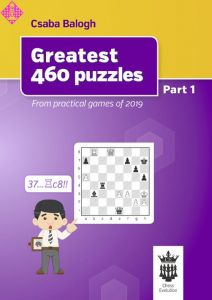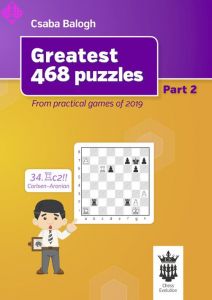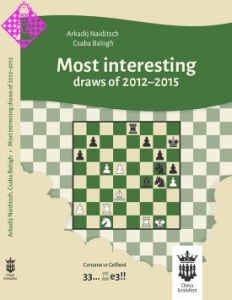Artikelnummer
LOSEDWWTMLS
Autor
Winning with the Modern London System
223 Seiten, kartoniert, Chess Evolution, 1. Auflage 2016
Final vergriffen
INTRODUCTION
In this book the London System opening is presented using all of the most important games with thorough comments, through which the readers will have the opportunity to understand the essence of this opening, which in my opinion has a future ahead of it and a lot of space for growth and development. I would like to mention that the book comprises the most important parts of this opening, and also the ideas reached through the experience of playing games in tournaments, as well as the positions analysed in collaboration with Grandmaster Ferenc Berkes. But there should always be room, if a player chooses this opening, for some new interesting idea during the game itself, because either side (both White and Black) can encounter something new and unexplored in a relatively early phase of the game. Therein lies the beauty of chess: creativity, freedom to mix things up, and an abundance of possibilities and ideas for a game of high quality. I’m certain that this book will be very helpful to most chess players in building a strong foundation in order to be able to use this opening in praxis. At this point it’s important to say a few words about the move order. Many players enter this system with 2.Nf3 and 3.Bf4. Positions reached after 2.Nf3 are usually identical to those with 2.Bf4, but that move order is actually less elastic and it narrows down White’s options. It is for this reason that I am promoting the development of the bishop on the 2nd move as the main move order. Those differences in options will be the most obvious in chapters 2 and 4. In the process of writing this book the biggest problems for me arose from the different move orders used in the analysed games. In order to avoid confusing the readers, for each chapter there’s an introduction where the correct move order can be seen clearly. I’m using this opportunity to point out to readers that they definitely shouldn’t skip the introductions to the chapters!
At the present moment the London System is becoming increasingly popular at the top level even in ‘classical’ tournament games, although it’s much more often seen in rapid. Currently the top players who use it most frequently are American Grandmaster Gata Kamsky and Russian Grandmaster Boris Grachev, while other top players occasionally have it in their repertoire, usually using it as a surprise weapon. Among them are Magnus Carlsen, Vladimir Kramnik and others. Also a great contribution to this system came from the French Grandmaster Eric Prie, who plays it in a very original and active manner. One way or the other, what’s important are the facts which I obtained through my study of the London System and which I will prove in this book with a thorough analysis of games. I will show that this system is fully deserving of your attention for analysing and playing, that it’s unjustly neglected in comparison with other openings and also that it gives players myriad interesting positions on the board, free and creative play, with lots of space for further growth and improvement.
PREFACE
Every chess player is searching for a suitable opening repertoire throughout his career. In this search the player is trying to find a playing style and a position type that will suit his sensibility and character. I was likewise looking for openings based on my playing style in which I would feel free and comfortable while playing, without fear that I would be caught in unfamiliar territory facing my opponent’s theoretical superiority. I began my search in the earliest days, actually from my junior years when I played 1.e4 as White, striving strictly for mainlines in which I was achieving solid results. However, over time, the computer world has conquered chess and I realized that 1.e4 was too concrete for me. It was not allowing my playing style to express itself and I was not reaching positions in which I could show my true face. Also, I realized that 1.e4 couldn’t be played without thorough computer analysis, and I must admit that I still prefer the approach of an older generation; one which favours a chess book and a board in front of them and which likes to hold pieces in their hands while working on the development of their chess skills. So, my opinion about 1.e4 slowly began to change. At the age of 22 I decided to seriously focus on a study of 1.d4. However, I encountered one, should I say, obstacle and that was 1... d5! Just to mention that 1...Nf6 wasn’t a problem, because the positions arising weren’t symmetrical, while 1...d5 followed by the Slav Defence and the Queen’s Gambit was becoming an ‘impenetrable fortress’ which could be credited largely to Grandmaster Vladimir Kramnik.
I wish to emphasize that the problem for me at that time wasn’t being unable to find an advantage for White, because I think that if Black plays the opening phase precisely White can’t reach an advantage in almost any system (except when Black is using openings proven to be incorrect), but
the bigger issue was with the types of positions that were reached, which didn’t allow me to be free and creative. Also, the arising positions were deeply analysed by professional chess players with the help of very strong computer programs.
Continuing to explore 1.d4 I got an idea to check what one of my favourite players Anthony Miles had in his repertoire against 1...d5. Two games that left a strong impression on me were Miles Minasian, Ohrid 2001 and Miles Dominguez, Capablanca Memorial 2001. In those games Miles played 2. Bf4, which is known as the ”London System“. Back then I didn’t know much about that system, and actually didn’t care to know, because I saw mostly weaker players playing the ”London System“ and it seemed to me that they were using it with the purpose of achieving
a draw. It was precisely that attitude I had beforehand that helped me understand that maybe a great number of other players also had the same attitude, that they were underestimating the system and that maybe it should be analysed in greater detail and given a new meaning. I began to see that it could also serve as a very strong psychological weapon if studied well. The ”London System“ wasn’t played very often at the top level, it was relatively unexplored and it was precisely those conclusions that showed me that the eff ort should be made to thoroughly analyse this opening. The move 2. Bf4 is pretty underestimated and is not considered serious enough, but I think it’s completely natural and logical. White’s structure is natural, with positions similar to those from Slav Defence and Stonewall with reverse colours, but with the problem of the inactive bishop, the so called ”bad bishop“ solved at the very beginning! By the way, I successfully played both of those openings as Black. Having that experience with the black pieces in mind, the study of the ”London System“ wasn’t a problem for me because I was already well-acquainted with the ideas and types of positions arising. At the beginning of my exploration of this opening’s secrets I didn’t know if adequate literature about this system existed, so I relied mainly on the database, while I learned the most through my praxis and of course through analysis of my own games. The games of Croatian Grandmaster Vlatko Kovacevic were also a great infl uence on me. Help from my friends in analysis of the system was also very useful, so I often exchanged experiences and ideas with top Hungarian Grandmaster Ferenc Berkes, and I will take the liberty to say that it was a fruitful collaboration because I’m personally satisfied with the results achieved using the studied material. 10 years after my first game in the ”London System“ with more than 50 games played against many Grandmasters among others and with an overall performance over 2700 I felt free and confident enough to distil my experience into a book, its purpose being to serve as a guide for other players searching for an opening which they will play with pleasure. The ideas and ways of treating these positions have changed over time, and I put an emphasis on that which I currently consider to be best for White. This is the reason why the book is called Winning with the Modern London System. I have to mention that 1.d4 Nf6 2.Bf4 or 2.Nf3 with Bf4 are also known as the London System. Personally, I’m not a fan of the London System against 1...Nf6, especially when Black arranges his pieces as he would in the King’s Indian Defence. The position of the bishop on f4 seems adequate to me only when black plays 1...d5, in which case it has a very important role to play, as opposed to when Black has the option of playing ….d6 when the London set-up seems less logical and I don’t believe in it. So I chose to deal with the London System only against 1...d5 in this book!
In this book the London System opening is presented using all of the most important games with thorough comments, through which the readers will have the opportunity to understand the essence of this opening, which in my opinion has a future ahead of it and a lot of space for growth and development. I would like to mention that the book comprises the most important parts of this opening, and also the ideas reached through the experience of playing games in tournaments, as well as the positions analysed in collaboration with Grandmaster Ferenc Berkes. But there should always be room, if a player chooses this opening, for some new interesting idea during the game itself, because either side (both White and Black) can encounter something new and unexplored in a relatively early phase of the game. Therein lies the beauty of chess: creativity, freedom to mix things up, and an abundance of possibilities and ideas for a game of high quality. I’m certain that this book will be very helpful to most chess players in building a strong foundation in order to be able to use this opening in praxis. At this point it’s important to say a few words about the move order. Many players enter this system with 2.Nf3 and 3.Bf4. Positions reached after 2.Nf3 are usually identical to those with 2.Bf4, but that move order is actually less elastic and it narrows down White’s options. It is for this reason that I am promoting the development of the bishop on the 2nd move as the main move order. Those differences in options will be the most obvious in chapters 2 and 4. In the process of writing this book the biggest problems for me arose from the different move orders used in the analysed games. In order to avoid confusing the readers, for each chapter there’s an introduction where the correct move order can be seen clearly. I’m using this opportunity to point out to readers that they definitely shouldn’t skip the introductions to the chapters!
At the present moment the London System is becoming increasingly popular at the top level even in ‘classical’ tournament games, although it’s much more often seen in rapid. Currently the top players who use it most frequently are American Grandmaster Gata Kamsky and Russian Grandmaster Boris Grachev, while other top players occasionally have it in their repertoire, usually using it as a surprise weapon. Among them are Magnus Carlsen, Vladimir Kramnik and others. Also a great contribution to this system came from the French Grandmaster Eric Prie, who plays it in a very original and active manner. One way or the other, what’s important are the facts which I obtained through my study of the London System and which I will prove in this book with a thorough analysis of games. I will show that this system is fully deserving of your attention for analysing and playing, that it’s unjustly neglected in comparison with other openings and also that it gives players myriad interesting positions on the board, free and creative play, with lots of space for further growth and improvement.
PREFACE
Every chess player is searching for a suitable opening repertoire throughout his career. In this search the player is trying to find a playing style and a position type that will suit his sensibility and character. I was likewise looking for openings based on my playing style in which I would feel free and comfortable while playing, without fear that I would be caught in unfamiliar territory facing my opponent’s theoretical superiority. I began my search in the earliest days, actually from my junior years when I played 1.e4 as White, striving strictly for mainlines in which I was achieving solid results. However, over time, the computer world has conquered chess and I realized that 1.e4 was too concrete for me. It was not allowing my playing style to express itself and I was not reaching positions in which I could show my true face. Also, I realized that 1.e4 couldn’t be played without thorough computer analysis, and I must admit that I still prefer the approach of an older generation; one which favours a chess book and a board in front of them and which likes to hold pieces in their hands while working on the development of their chess skills. So, my opinion about 1.e4 slowly began to change. At the age of 22 I decided to seriously focus on a study of 1.d4. However, I encountered one, should I say, obstacle and that was 1... d5! Just to mention that 1...Nf6 wasn’t a problem, because the positions arising weren’t symmetrical, while 1...d5 followed by the Slav Defence and the Queen’s Gambit was becoming an ‘impenetrable fortress’ which could be credited largely to Grandmaster Vladimir Kramnik.
I wish to emphasize that the problem for me at that time wasn’t being unable to find an advantage for White, because I think that if Black plays the opening phase precisely White can’t reach an advantage in almost any system (except when Black is using openings proven to be incorrect), but
the bigger issue was with the types of positions that were reached, which didn’t allow me to be free and creative. Also, the arising positions were deeply analysed by professional chess players with the help of very strong computer programs.
Continuing to explore 1.d4 I got an idea to check what one of my favourite players Anthony Miles had in his repertoire against 1...d5. Two games that left a strong impression on me were Miles Minasian, Ohrid 2001 and Miles Dominguez, Capablanca Memorial 2001. In those games Miles played 2. Bf4, which is known as the ”London System“. Back then I didn’t know much about that system, and actually didn’t care to know, because I saw mostly weaker players playing the ”London System“ and it seemed to me that they were using it with the purpose of achieving
a draw. It was precisely that attitude I had beforehand that helped me understand that maybe a great number of other players also had the same attitude, that they were underestimating the system and that maybe it should be analysed in greater detail and given a new meaning. I began to see that it could also serve as a very strong psychological weapon if studied well. The ”London System“ wasn’t played very often at the top level, it was relatively unexplored and it was precisely those conclusions that showed me that the eff ort should be made to thoroughly analyse this opening. The move 2. Bf4 is pretty underestimated and is not considered serious enough, but I think it’s completely natural and logical. White’s structure is natural, with positions similar to those from Slav Defence and Stonewall with reverse colours, but with the problem of the inactive bishop, the so called ”bad bishop“ solved at the very beginning! By the way, I successfully played both of those openings as Black. Having that experience with the black pieces in mind, the study of the ”London System“ wasn’t a problem for me because I was already well-acquainted with the ideas and types of positions arising. At the beginning of my exploration of this opening’s secrets I didn’t know if adequate literature about this system existed, so I relied mainly on the database, while I learned the most through my praxis and of course through analysis of my own games. The games of Croatian Grandmaster Vlatko Kovacevic were also a great infl uence on me. Help from my friends in analysis of the system was also very useful, so I often exchanged experiences and ideas with top Hungarian Grandmaster Ferenc Berkes, and I will take the liberty to say that it was a fruitful collaboration because I’m personally satisfied with the results achieved using the studied material. 10 years after my first game in the ”London System“ with more than 50 games played against many Grandmasters among others and with an overall performance over 2700 I felt free and confident enough to distil my experience into a book, its purpose being to serve as a guide for other players searching for an opening which they will play with pleasure. The ideas and ways of treating these positions have changed over time, and I put an emphasis on that which I currently consider to be best for White. This is the reason why the book is called Winning with the Modern London System. I have to mention that 1.d4 Nf6 2.Bf4 or 2.Nf3 with Bf4 are also known as the London System. Personally, I’m not a fan of the London System against 1...Nf6, especially when Black arranges his pieces as he would in the King’s Indian Defence. The position of the bishop on f4 seems adequate to me only when black plays 1...d5, in which case it has a very important role to play, as opposed to when Black has the option of playing ….d6 when the London set-up seems less logical and I don’t believe in it. So I chose to deal with the London System only against 1...d5 in this book!
| EAN | 9788394429096 |
|---|---|
| Gewicht | 440 g |
| Hersteller | Chess Evolution |
| Breite | 17 cm |
| Höhe | 24 cm |
| Medium | Buch |
| Erscheinungsjahr | 2016 |
| Autor | Nikola Sedlak |
| Sprache | Englisch |
| Auflage | 1 |
| ISBN-13 | 978-8394429096 |
| Seiten | 223 |
| Einband | kartoniert |
| Name | Chess Evolution |
|---|
004 KEY TO SYMBOLS
005 PREFACE
009 INTRODUCTION
011 THE NARROW PATH OF ADVERSITY: A BRIEF HISTORY
021 CHAPTER ONE - CARO-KANN POSITION
055 CHAPTER TWO - EARLY QB6-C4
073 CHAPTER THREE - CLASICAL SET-UP WITHOUT E6
097 CHAPTER FOUR - CLASSICAL SET-UP WITH …E6
143 CHAPTER FIVE - EARLY …E6
161 CHAPTER SIX - SLAV SET-UP - 2...C6 AND SYMMETRY 2...BF5
183 CHAPTER SEVEN - GRÜNFELD SET-UP
193 CHAPTER EIGHT - QUEEN’S GAMBIT SET-UP
201 CHAPTER NINE - CHIGORIN SET-UP AND 2...BG4
211 CHAPTER TEN - TYPICAL ENDGAMES: LONDON SYSTEM
223 CONCLUSION
005 PREFACE
009 INTRODUCTION
011 THE NARROW PATH OF ADVERSITY: A BRIEF HISTORY
021 CHAPTER ONE - CARO-KANN POSITION
055 CHAPTER TWO - EARLY QB6-C4
073 CHAPTER THREE - CLASICAL SET-UP WITHOUT E6
097 CHAPTER FOUR - CLASSICAL SET-UP WITH …E6
143 CHAPTER FIVE - EARLY …E6
161 CHAPTER SIX - SLAV SET-UP - 2...C6 AND SYMMETRY 2...BF5
183 CHAPTER SEVEN - GRÜNFELD SET-UP
193 CHAPTER EIGHT - QUEEN’S GAMBIT SET-UP
201 CHAPTER NINE - CHIGORIN SET-UP AND 2...BG4
211 CHAPTER TEN - TYPICAL ENDGAMES: LONDON SYSTEM
223 CONCLUSION
"Winning with the Modern London System" vom serbischen Großmeister Nikola Sedlak folgt dem Anspruch, Weiß ein vollständiges und abgesichertes Repertoire für den Fall an die Hand zu geben, dass sein Gegner auf 1.d4 mit 1…d5 antwortet. Er spricht vom "Modern London System", um schon über die Namensgebung eine Abgrenzung der von ihm besprochenen Spielweise von einem Teilbereich des Systems zu erreichen. Sie wird mit 2.Lf4 eingeleitet und ist nur dann seine Empfehlung, wenn Schwarz tatsächlich zu d7-d5 gegriffen hat.
Nach seinen Worten hat er sich von seinem Idol Tony Miles inspiriert gefühlt, als er sich vor Jahren dieser Eröffnungsidee zuwendete. Seit 2005 gehört die Eröffnung zu seinem festen Repertoire. Er hat Erfolg damit und einen großen Erfahrungsschatz aufgebaut, den er ins Werk eingebracht hat.
Sedlak behandelt den Stoff anhand von praktischen Partien, von denen er eine Reihe selbst gespielt hat. Neun von zehn Kapiteln im Werk sollen den Leser mit dem Ziel anleiten, ihn gut aus der Eröffnung in die Partie kommen zu lassen. Ein zehntes Kapitel verfolgt den Ansatz, dass er bestimmte Endspiele zu erreichen oder auch zu vermeiden lernen soll. Den Erörterungen der Theorie vorangestellt ist eine kurze historische Einführung des Systems, um dem Leser etwas Hintergrundwissen anzubieten und ihn vielleicht auch schon etwas auf den Geschmack zu bringen.
Entsprechend sieht das Inhaltsverzeichnis - im "Deutsch-Englisch-Mix" - zum Kernbereich der Betrachtungen wie folgt aus:
Kapitel 1: Caro-Kann Position
Kapitel 2: Early Db6-c4
Kapitel 3: - Classical Set-Up without e6
Kapitel 4: - Classical Set-up with e6
Kapitel 5: - Early ... e6
Kapitel 6: - Slav Set-Up - 2...c6 and symmetry 2...Lf5
Kapitel 7: - Grünfeld Set-Up
Kapitel 8: - Queens's Gambit Set-Up
Kapitel 9: - Chigorin Set-Up and 2...Lg4
Kapitel 10: - Typical Endgames: London System.
Die Kapitel beginnen mit einer kurzen theoretischen Einführung, die den Leser über die wesentlichen Aspekte zur Strategie und Taktik der jeweiligen Spielweise aufklärt. Entsprechend ist es ihm dringend anzuraten, auch genau damit zu beginnen und nicht etwa zu den Partien des Kapitels zu springen. Mit den einleitenden Informationen auf der Habenseite kann er sich dann an die Arbeit mit den Partien machen.
Im Vorgehen Sedlaks beim Einsatz der Partien gibt es drei Besonderheiten, die mir sehr gut gefallen. Zunächst bereitet er den Leser darauf vor, was ihm im Folgenden vermittelt werden soll. Er stellt die wesentlichen Aspekte der Begegnung heraus und zeigt auf, was daraus geschlossen werden kann. Entsprechend kann der Leser sein Augenmerk auf diese Gegenstände richten, während er im Stoff voranschreitet. Wenn sich ein Vergleich zum Handeln eines Spielers in einer anderen Partie anbietet, macht Sedlak auch darauf aufmerksam.
Als eine sehr gute Entscheidung sehe ich die Angabe jeweils der Theoriezugfolge an, wenn die Partie unter Zugumstellungen oder sogar aus anderen Eröffnungen in Buchvarianten übertritt. Beispielsweise kann sie auch über Caro-Kann gelaufen sein, sich also auch aus einer Eröffnung mit dem e-Bauern ergeben. Der Leser behält so den vollen Überblick darüber, wie "sein System" nach seinem Aufschlag mit dem d-Bauern auf geradem Weg verläuft und kann außer Acht lassen, dass die Spieler der jeweiligen Beispielpartie auf Umwegen dorthin gekommen sind.
Sehr gelungen sind für mich auch Schlussfolgerungen nach der Erörterung eines Themas und Zusammenstellungen dessen, was der Leser aus einer vorangegangenen Besprechung lernen sollte. Hier erfährt er ganz konkret das Wichtigste, was er für seine eigene Spielanlage und Partieführung konkret beherzigen sollte. Nicht selten formuliert Sedlak an dieser Stelle eine Art Merksätze, die sich einzuprägen lohnen.
Die Einführung einer Partie, die erheblichen Textanteile in der Kommentierung sowie die nachgehende Zusammenfassung bilden eine bemerkenswerte Einheit. Der Leser wird mit dem System vertraut gemacht. Er soll ein Gespür für dessen Anforderungen bekommen und zugleich konkrete Aspekte erlernen können.
Ich vermisse allerdings ein Variantenverzeichnis. Sowohl dem lernenden Leser als auch jenem, der zu einer Spielweise etwas nachschlagen möchte, wird die Orientierung im Buch nicht leicht gemacht. Ein Partien- und ein Spielerverzeichnis, die ebenfalls nicht enthalten sind, sind da schon eher als fehlend zu verkraften.
Das zehnte Kapitel, also jenes mit der Ausrichtung auf Endspielstellungen, hätte nach meinem Geschmack direkter sein dürfen und etwas mehr Umfang haben können. Hier hätte sich die Arbeit mit Fragmenten anbieten können. Der positive Ansatz, das Endspiel zumindest in entscheidenden Situationen bzw. zu generalisierbaren Aspekten in die Betrachtungen einzubeziehen, wird ein Stück weit entwertet. In der realisierten Weise bleibt das Werk hier zu oberflächlich.
Das Buch ist in englischer Sprache unter dem polnischen Label "Chess Evolution" erschienen und eine Neuerscheinung aus 2016. Fremdsprachkenntnisse auf Schulniveau reichen zum Verstehen aus, auch wenn nicht immer "korrektes Englisch" im Buch zu finden ist. Fremdsprachlich nicht ganz so geübte Leser werden vielleicht auf den ersten Seiten etwas Mühe haben, weil dort einiges an Text auf sie wartet. Allerdings sind die Ausführungen dort für denjenigen, den allein die Theorie interessiert, entbehrlich. Ihm entgehen dann mehr oder weniger nur einige einführende Worte und etwas Hintergrundwissen.
Fazit: Wer sich nach 1.d4 d5 mit 2.Lf4 ein Spezialrepertoire aufbauen möchte, findet in "Winning with the Modern London System" ein Buch im Regal, das ihm sehr gut helfen kann. Es stellt das System anschaulich dar und gibt sich große Mühe, den Leser verstehen zu lassen und anzuleiten. Das System selbst vermittelt die Chance, Berge von Eröffnungstheorie zu umschiffen.
So ist das Werk für mich eine Empfehlung für jeden Klubspieler und ein Ideengeber darüber hinaus.
Uwe Bekemann
www.BdF-Fernschachbund.de
Oktober 2016
Das Londoner mit 1.d4 und 2.Lf4 ist derzeit nicht nur auf Großmeisterebene beliebt, wo es von Carlsen, Kramnik und Co gespielt wird, auch auf dem Büchermarkt gibt es von einigen Verlagen Neuerscheinungen. Ich möchte mich in diesem Artikel näher mit "Winning with the modern London System" von Großmeister Nikola Sedlak aus dem Chess Evolution Verlag beschäftigen. Dieses Buch hat schon ohne Lektüre einige positive Begleitumstände. Erst einmal ist der herausgebende Verlag noch recht frisch und hat zuletzt einige gute Bücher veröffentlicht, dann spielt der starke Autor die Eröffnung auch selbst und das sehr erfolgreich und das Buch beschränkt sich auf 1.d4 d5 2.Lf4. Gerade nach 1. ...d5 erscheint der Läuferzug am besten, da Schwarz ihm keinen Bauern auf d6 mehr entgegenstellen kann, um seine Aktivität zu bremsen.
Mit dem Londoner System, das im allgemeinen auch als "Rentner" bezeichnet wird, da Weiß mit 1.d4 und dann Lf4, Sf3, e3, Ld3, c3, Sbd2 quasi im Autopilot eine nur schwer einnehmbare Festung errichtet, hat die hier beschriebene Eröffnungsvariante allerdings nicht viel gemein. Das Buch ist auf recht hohem Niveau geschrieben und es geht oft um präzise Zugreihenfolgen in der Eröffnung, um mit Weiß Vorteil zu erreichen. Zudem wird nicht nur die gängige Theorie dargestellt, sondern auch bereichert.
Eine wichtige Feinheit ist dabei das Zurückstellen von Sf3. So hat Weiß zum Beispiel in der Buchvariante 1.d4 d5 2.Lf4 c5 3.e3 Sc6 4.c3 Db6 5.Db3 c4 6.Dc2 nach Sf6, Lf5 wird mit 7.Dxf5 ansprechend widerlegt, 7. Sd2 den störenden Zug Lf5 verhindert und kann nach 7. ...g6, um ihn vorzubereiten, mit 8.e4 im Zentrum aktiv werden, während nach 7.Sf3 Lf5 ein guter Zug ist, der nach 8.Dc1 e6 zu einer recht aktiven Stellung für Schwarz führt. Der Unterschied bei 6. ...Lf5 ist, dass Weiß nach 7.Dxf5 Dxb2 8.Dxd5 für die Minusqualität ein paar Bauern und Angriff erhält. Dies wird im Buch sehr genau analysiert.
Dies ist allerdings schon länger bekannt. Für mich neu war allerdings unter anderem die Idee 1.d4 d5 2.Lf4 Sf6 3.e3 e6 4.Sd2 Ld6 5.Lg3 c5 6.c3 Sc6 7.Sgf3 0-0 8.Ld3 b6 9.Se5, 9.e4 wird auch ausführlich analysiert, Lb7 10.f4 Se7 11.Db1. Damit wird der schwarze Standardplan Sf5 nebst Se4 mit einer aktiven Stellung verhindert , der auch für mich zu einigen netten Schwarzsiegen führte. Hierzu gibt es kaum Partienmaterial, aber der Autor zeigt einige interessante Angriffswege für Weiß auf.
Er verwendet dabei unter anderem auch einige Partien von sich und hat sichtlich viel Zeit und Herzblut in diese Eröffnung gesteckt, was dem Buch sehr gut tut. Typische taktische Wendungen und Pläne werden anhand von Varianten und verbalen Erläuterungen in vollständigen Modellpartien gut erklärt und es gibt als Extra noch einen historischen Abriss zu der Variante sowie ein Kapitel zu typischen "Londonendspielen", die zuvor noch nicht erwähnt worden waren. Letzteres kam mir etwas zu kurz vor, aber dennoch erscheint das ganze Buch stimmig. Das größte Manko ist vielleicht noch die holprige englische Sprache plus auffallend viele Rechtschreibfehler, aber das ist dann schon Jammern auf hohem Niveau.
Von mir gibt es eine klare Kaufempfehlung!
IM Dirk Schuh
September 2016
Nach seinen Worten hat er sich von seinem Idol Tony Miles inspiriert gefühlt, als er sich vor Jahren dieser Eröffnungsidee zuwendete. Seit 2005 gehört die Eröffnung zu seinem festen Repertoire. Er hat Erfolg damit und einen großen Erfahrungsschatz aufgebaut, den er ins Werk eingebracht hat.
Sedlak behandelt den Stoff anhand von praktischen Partien, von denen er eine Reihe selbst gespielt hat. Neun von zehn Kapiteln im Werk sollen den Leser mit dem Ziel anleiten, ihn gut aus der Eröffnung in die Partie kommen zu lassen. Ein zehntes Kapitel verfolgt den Ansatz, dass er bestimmte Endspiele zu erreichen oder auch zu vermeiden lernen soll. Den Erörterungen der Theorie vorangestellt ist eine kurze historische Einführung des Systems, um dem Leser etwas Hintergrundwissen anzubieten und ihn vielleicht auch schon etwas auf den Geschmack zu bringen.
Entsprechend sieht das Inhaltsverzeichnis - im "Deutsch-Englisch-Mix" - zum Kernbereich der Betrachtungen wie folgt aus:
Kapitel 1: Caro-Kann Position
Kapitel 2: Early Db6-c4
Kapitel 3: - Classical Set-Up without e6
Kapitel 4: - Classical Set-up with e6
Kapitel 5: - Early ... e6
Kapitel 6: - Slav Set-Up - 2...c6 and symmetry 2...Lf5
Kapitel 7: - Grünfeld Set-Up
Kapitel 8: - Queens's Gambit Set-Up
Kapitel 9: - Chigorin Set-Up and 2...Lg4
Kapitel 10: - Typical Endgames: London System.
Die Kapitel beginnen mit einer kurzen theoretischen Einführung, die den Leser über die wesentlichen Aspekte zur Strategie und Taktik der jeweiligen Spielweise aufklärt. Entsprechend ist es ihm dringend anzuraten, auch genau damit zu beginnen und nicht etwa zu den Partien des Kapitels zu springen. Mit den einleitenden Informationen auf der Habenseite kann er sich dann an die Arbeit mit den Partien machen.
Im Vorgehen Sedlaks beim Einsatz der Partien gibt es drei Besonderheiten, die mir sehr gut gefallen. Zunächst bereitet er den Leser darauf vor, was ihm im Folgenden vermittelt werden soll. Er stellt die wesentlichen Aspekte der Begegnung heraus und zeigt auf, was daraus geschlossen werden kann. Entsprechend kann der Leser sein Augenmerk auf diese Gegenstände richten, während er im Stoff voranschreitet. Wenn sich ein Vergleich zum Handeln eines Spielers in einer anderen Partie anbietet, macht Sedlak auch darauf aufmerksam.
Als eine sehr gute Entscheidung sehe ich die Angabe jeweils der Theoriezugfolge an, wenn die Partie unter Zugumstellungen oder sogar aus anderen Eröffnungen in Buchvarianten übertritt. Beispielsweise kann sie auch über Caro-Kann gelaufen sein, sich also auch aus einer Eröffnung mit dem e-Bauern ergeben. Der Leser behält so den vollen Überblick darüber, wie "sein System" nach seinem Aufschlag mit dem d-Bauern auf geradem Weg verläuft und kann außer Acht lassen, dass die Spieler der jeweiligen Beispielpartie auf Umwegen dorthin gekommen sind.
Sehr gelungen sind für mich auch Schlussfolgerungen nach der Erörterung eines Themas und Zusammenstellungen dessen, was der Leser aus einer vorangegangenen Besprechung lernen sollte. Hier erfährt er ganz konkret das Wichtigste, was er für seine eigene Spielanlage und Partieführung konkret beherzigen sollte. Nicht selten formuliert Sedlak an dieser Stelle eine Art Merksätze, die sich einzuprägen lohnen.
Die Einführung einer Partie, die erheblichen Textanteile in der Kommentierung sowie die nachgehende Zusammenfassung bilden eine bemerkenswerte Einheit. Der Leser wird mit dem System vertraut gemacht. Er soll ein Gespür für dessen Anforderungen bekommen und zugleich konkrete Aspekte erlernen können.
Ich vermisse allerdings ein Variantenverzeichnis. Sowohl dem lernenden Leser als auch jenem, der zu einer Spielweise etwas nachschlagen möchte, wird die Orientierung im Buch nicht leicht gemacht. Ein Partien- und ein Spielerverzeichnis, die ebenfalls nicht enthalten sind, sind da schon eher als fehlend zu verkraften.
Das zehnte Kapitel, also jenes mit der Ausrichtung auf Endspielstellungen, hätte nach meinem Geschmack direkter sein dürfen und etwas mehr Umfang haben können. Hier hätte sich die Arbeit mit Fragmenten anbieten können. Der positive Ansatz, das Endspiel zumindest in entscheidenden Situationen bzw. zu generalisierbaren Aspekten in die Betrachtungen einzubeziehen, wird ein Stück weit entwertet. In der realisierten Weise bleibt das Werk hier zu oberflächlich.
Das Buch ist in englischer Sprache unter dem polnischen Label "Chess Evolution" erschienen und eine Neuerscheinung aus 2016. Fremdsprachkenntnisse auf Schulniveau reichen zum Verstehen aus, auch wenn nicht immer "korrektes Englisch" im Buch zu finden ist. Fremdsprachlich nicht ganz so geübte Leser werden vielleicht auf den ersten Seiten etwas Mühe haben, weil dort einiges an Text auf sie wartet. Allerdings sind die Ausführungen dort für denjenigen, den allein die Theorie interessiert, entbehrlich. Ihm entgehen dann mehr oder weniger nur einige einführende Worte und etwas Hintergrundwissen.
Fazit: Wer sich nach 1.d4 d5 mit 2.Lf4 ein Spezialrepertoire aufbauen möchte, findet in "Winning with the Modern London System" ein Buch im Regal, das ihm sehr gut helfen kann. Es stellt das System anschaulich dar und gibt sich große Mühe, den Leser verstehen zu lassen und anzuleiten. Das System selbst vermittelt die Chance, Berge von Eröffnungstheorie zu umschiffen.
So ist das Werk für mich eine Empfehlung für jeden Klubspieler und ein Ideengeber darüber hinaus.
Uwe Bekemann
www.BdF-Fernschachbund.de
Oktober 2016
Das Londoner mit 1.d4 und 2.Lf4 ist derzeit nicht nur auf Großmeisterebene beliebt, wo es von Carlsen, Kramnik und Co gespielt wird, auch auf dem Büchermarkt gibt es von einigen Verlagen Neuerscheinungen. Ich möchte mich in diesem Artikel näher mit "Winning with the modern London System" von Großmeister Nikola Sedlak aus dem Chess Evolution Verlag beschäftigen. Dieses Buch hat schon ohne Lektüre einige positive Begleitumstände. Erst einmal ist der herausgebende Verlag noch recht frisch und hat zuletzt einige gute Bücher veröffentlicht, dann spielt der starke Autor die Eröffnung auch selbst und das sehr erfolgreich und das Buch beschränkt sich auf 1.d4 d5 2.Lf4. Gerade nach 1. ...d5 erscheint der Läuferzug am besten, da Schwarz ihm keinen Bauern auf d6 mehr entgegenstellen kann, um seine Aktivität zu bremsen.
Mit dem Londoner System, das im allgemeinen auch als "Rentner" bezeichnet wird, da Weiß mit 1.d4 und dann Lf4, Sf3, e3, Ld3, c3, Sbd2 quasi im Autopilot eine nur schwer einnehmbare Festung errichtet, hat die hier beschriebene Eröffnungsvariante allerdings nicht viel gemein. Das Buch ist auf recht hohem Niveau geschrieben und es geht oft um präzise Zugreihenfolgen in der Eröffnung, um mit Weiß Vorteil zu erreichen. Zudem wird nicht nur die gängige Theorie dargestellt, sondern auch bereichert.
Eine wichtige Feinheit ist dabei das Zurückstellen von Sf3. So hat Weiß zum Beispiel in der Buchvariante 1.d4 d5 2.Lf4 c5 3.e3 Sc6 4.c3 Db6 5.Db3 c4 6.Dc2 nach Sf6, Lf5 wird mit 7.Dxf5 ansprechend widerlegt, 7. Sd2 den störenden Zug Lf5 verhindert und kann nach 7. ...g6, um ihn vorzubereiten, mit 8.e4 im Zentrum aktiv werden, während nach 7.Sf3 Lf5 ein guter Zug ist, der nach 8.Dc1 e6 zu einer recht aktiven Stellung für Schwarz führt. Der Unterschied bei 6. ...Lf5 ist, dass Weiß nach 7.Dxf5 Dxb2 8.Dxd5 für die Minusqualität ein paar Bauern und Angriff erhält. Dies wird im Buch sehr genau analysiert.
Dies ist allerdings schon länger bekannt. Für mich neu war allerdings unter anderem die Idee 1.d4 d5 2.Lf4 Sf6 3.e3 e6 4.Sd2 Ld6 5.Lg3 c5 6.c3 Sc6 7.Sgf3 0-0 8.Ld3 b6 9.Se5, 9.e4 wird auch ausführlich analysiert, Lb7 10.f4 Se7 11.Db1. Damit wird der schwarze Standardplan Sf5 nebst Se4 mit einer aktiven Stellung verhindert , der auch für mich zu einigen netten Schwarzsiegen führte. Hierzu gibt es kaum Partienmaterial, aber der Autor zeigt einige interessante Angriffswege für Weiß auf.
Er verwendet dabei unter anderem auch einige Partien von sich und hat sichtlich viel Zeit und Herzblut in diese Eröffnung gesteckt, was dem Buch sehr gut tut. Typische taktische Wendungen und Pläne werden anhand von Varianten und verbalen Erläuterungen in vollständigen Modellpartien gut erklärt und es gibt als Extra noch einen historischen Abriss zu der Variante sowie ein Kapitel zu typischen "Londonendspielen", die zuvor noch nicht erwähnt worden waren. Letzteres kam mir etwas zu kurz vor, aber dennoch erscheint das ganze Buch stimmig. Das größte Manko ist vielleicht noch die holprige englische Sprache plus auffallend viele Rechtschreibfehler, aber das ist dann schon Jammern auf hohem Niveau.
Von mir gibt es eine klare Kaufempfehlung!
IM Dirk Schuh
September 2016
Mehr von Chess Evolution
-
 Pearls of Azerbaijan19,95 €
Pearls of Azerbaijan19,95 € -
 Defensive tools22,95 €
Defensive tools22,95 € - Mehr von Chess Evolution






